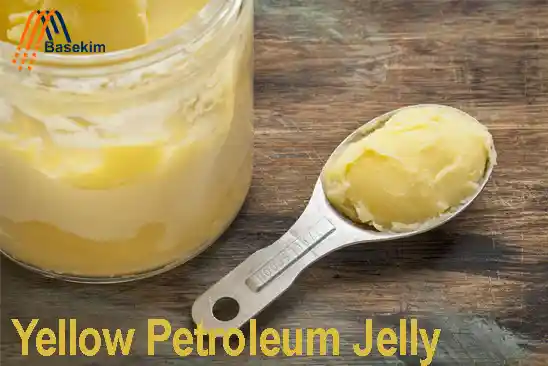
Yellow petroleum jelly is a versatile semi-solid substance widely used across industries and consumer products. Also known as yellow petrolatum, it is a form of petroleum jelly that has a natural yellow hue. This slight color difference comes from its level of refinement – yellow petroleum jelly is less refined than the familiar white petroleum jelly, meaning it may contain tiny amounts of impurities that give it a yellowish tint. Despite this, yellow petroleum jelly retains the same fundamental properties that make vaseline so useful: it’s an excellent lubricant, protectant, and moisturizer. In this comprehensive guide, we’ll explain exactly what yellow vaseline is, explore all applications in various fields, discuss considerations for all buyers, and highlight a reliable supplier (Basekim) from the UAE and Turkey. By the end, you’ll understand how to use this product effectively and what to look for when purchasing it.
Yellow petroleum jelly is a semi-solid mixture of hydrocarbons (mineral oils and waxes) derived from crude oil. It has a smooth, gel-like texture and is nearly odorless. Like its white counterpart, yellow petroleum jelly was originally discovered in the 19th century as a residue in oil rigs and later purified for commercial use. In essence, yellow vaseline is simply petroleum jelly with a yellow color. This color indicates it’s not as highly refined as white petroleum jelly; however, it still shares most of the same characteristics and uses.
How does it differ from white petroleum jelly? The primary difference lies in purification and color. White vaseline is more refined and has had impurities removed to achieve a clear or white appearance, whereas yellow vaseline undergoes less refining, retaining a yellowish hue due to trace impurities. These impurities are usually harmless oils or waxes that remain from the refining process. As a result, white petroleum jelly is typically used in applications where higher purity is required (cosmetics, medical ointments, etc.), while yellow petroleum jelly is often favored for industrial purposes where slight color or odor is not an issue. Importantly, both types are hydrophobic (water-repelling) and inert, meaning they do not react easily with other substances – a key reason for their widespread use as protective barriers and lubricants.
Moreover, yellow petroleum jelly shares the moisturizing and protective qualities of white petroleum jelly. It forms an occlusive layer on surfaces (such as skin or metal), which locks in moisture and shields against external elements. Because of these properties, yellow petroleum jelly finds use in an impressive range of applications despite its lower refinement.
Yellow petroleum jelly is prized for its versatility. It serves important functions in both personal care and industrial domains. Below are the major applications.
Skin Moisturizer and Protectant: Yellow vaseline is an excellent emollient. People apply it on dry or chapped skin, cracked heels, and lips to lock in moisture. It also shields skin from harsh weather. Additionally, it helps prevent diaper rash in babies by protecting the skin from excessive moisture.
Cosmetic Product Ingredient: It serves as a base in lip balms, lotions, creams, hair pomades, and salves. It mixes easily with fragrances and active ingredients, providing texture and shine.
Yellow petroleum jelly acts as a base for medicated ointments and salves. In fact, it keeps active medicinal ingredients in contact with the skin, and moreover, on its own it protects minor wounds by keeping out dirt and bacteria.
Medical and Pharmaceutical Uses
Wound Care and Skin Protection: Used as a protective dressing on minor wounds, surgical incisions, or burns. It creates a seal that reduces infection risk and keeps bandages from sticking.
Medical Device Lubrication: Applied as a lubricant for medical devices such as catheters, thermometers, or gloves, reducing friction without harsh chemicals.
Pharmaceutical Formulations: Many medicinal creams and ointments use petroleum jelly as their base. Yellow petroleum jelly refined to medical standards can be used in these formulations.
Machinery Lubrication: Used as a light lubricant for gears, bearings, hinges, and sliding parts.
Rust and Corrosion Prevention: Applied on metal surfaces, tools, or battery terminals to keep moisture and oxygen out, preventing rust.
Sealing and Gasketing: Coated on O-rings, threads, and gaskets to ensure better sealing and make disassembly easier.
Electrical Insulation: Used on battery terminals, spark plugs, and cable connections to keep moisture out and prevent corrosion.
Release Agent in Molding: Helps release rubber, plaster, or plastic molds easily by coating them with a thin petroleum jelly layer.
Leather and Rubber Conditioning: Maintains the flexibility of leather goods, rubber seals, and hoses by preventing them from drying or cracking.
When purchasing yellow vaseline, consider the following:
Grades and Purity:
Industrial grade for machinery.
Cosmetic grade for personal care formulations.
Pharmaceutical grade for medical or skin-contact products.
Packaging and Quantity: Available in drums, pails, or jars. Choose packaging that matches your operation size.
Quality and Certification: Look for compliance with standards like USP, BP, or FDA regulations. Ensure smooth, odorless quality.
Reliable Suppliers: Work with experienced suppliers. For example, Basekim, operating from UAE and Turkey, is a known exporter of petroleum jelly for medical, cosmetic, and industrial uses.
Regulatory Considerations: Check your country’s import rules and ask suppliers for documents such as Material Safety Data Sheets.
A: White petroleum jelly is more refined and pure, used mainly in cosmetics and medicine. Yellow petroleum jelly is less refined, has a yellow color, and is often used for industrial purposes.
A: Yes, when it’s cosmetic or pharmaceutical grade. It works well for dry skin, lips, diaper rash, and minor wounds.
A: From specialized suppliers. Basekim in UAE and Turkey is one trusted source, providing bulk petroleum jelly for global buyers.
A: Typically 3–5 years, but if stored properly in a cool, dry place, it can last even longer.